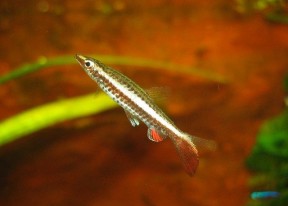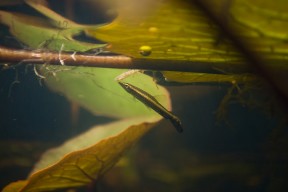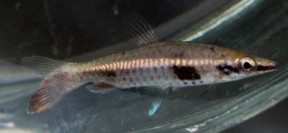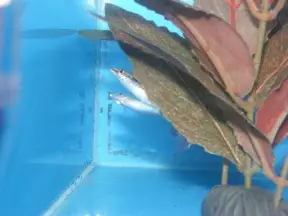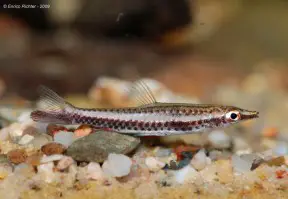Nannostomus eques
Hockeystick Pencilfish
SynonymsTop ↑
Poeciliobrycon eques (Steindachner, 1876); Poeciliobrycon auratus Eigenmann, 1909
Etymology
Nannostomus: from the Latin nannus, meaning ‘small‘, and Greek stoma, meaning ‘mouth’, in reference to the small mouthparts of member species.
eques: from the Latin eques, meaning ‘knight, horseman, rider’, in reference to this species’ oblique swimming angle.
Classification
Order: Characiformes Family: Lebiasinidae
Distribution
Described from the Peruvian Amazon above Tabatinga, the latter being located in the Três Fronteiras region of Amazonas state, northwestern Brazil, where the borders of Brazil, Peru, and Colombia meet.
It’s since been recorded throughout the central and upper Amazon region in Brazil, Peru, and Colombia including the rios Tapajós, Trombetas, Madeira, Negro, Japurá, Içá, and Putumayo, and is also known from the Orinoco drainage in Venezuela and and Colombia (Guaviare and Inírida tributary systems) plus various rivers of Guyana including the Essequibo and Curuni.
Genetic reserach has revealed that populations from the upper and middle/lower rio Negro in Brazil represent separate evolutionary units and do not hybridise at the one locality where they occur sympatrically (the Igarapé Jacuná, a tributary of the middle Negro).
Although appearing identical, populations from the middle and lower Negro were more closely-related to the congener N. unifasciatus than N. eques populations from the upper Negro for example, thus raising the possibility that the species as currently recognised may represent a complex of reproductively-isolated cryptic taxa.
Habitat
Inhabits sluggish tributaries, small rivers, and swampy zones, especially in areas where aquatic vegetation grows densely or with submerged woody structures and leaf litter.
It’s often found in areas of flooded forest and floodplain lakes in blackwater regions.
In a small rivulet of the lower río Atabapo, Colombia, it was recorded in a typical blackwater habitat with clear, acidic, tea-coloured water in shallow water of 10-50 cm depth among submerged terrestrial vegetation.
PH was recorded to be 4.4, conductivity 10 µS/cm, total and temporary hardness < 1°dH, and water temperature 24.4°C/75.9°F.
Sympatric species included Dicrossus gladicauda, Hemigrammus bleheri, Hyphessobrycon stictus, Paracheirodon axelrodi, Copella meinkeni, and Apistogramma uapesi, while in slightly deeper water Mesonauta insignis and Biotodoma wavrini were observed.
Maximum Standard Length
25 – 35 mm.
Aquarium SizeTop ↑
Base dimensions of at least 60 ∗ 30 cm or equivalent are required.
Maintenance
Should ideally be kept in a heavily-planted set-up, preferably with a dark substrate and some patches of floating vegetation around which the fish will tend to congregate, bodies angled towards the surface.
Driftwood branches and dried leaf litter can also be added, the latter in particular driving establishment of microbe colonies as decomposition occurs.
Such microorganisms can provide a valuable secondary food source for fry, whilst the tannins and other chemicals released by the decaying leaves are also thought beneficial.
Use gentle filtration; an air-powered sponge-style unit should prove adequate in most cases though a degree of flow is acceptable.
Water Conditions
Temperature: 22 – 28 °C
pH: 4.5 – 7.5
Hardness: 18 – 179 ppm
Diet
A micropredator feeding on tiny invertebrates and other zooplankton in nature.
In the aquarium it will accept dried foods of a suitable size but should also be offered daily meals of small live and frozen fare such as Artemia nauplii, Moina, grindal worm, etc.
Behaviour and CompatibilityTop ↑
Very peaceful but does not make an ideal community fish due to its small size and rather timid nature.
In a community it’s best kept with similarly-sized, peaceful characids and smaller callichthyid or loricariid catfishes.
It also makes an ideal dither fish for Apistogramma spp. and other dwarf cichlids since it tends to inhabit the middle-to-upper regions of the tank, and does not actively predate fry.
It’s very much a gregarious animal so buy as many as possible, ideally 10 or more, as when kept in larger groups any aggression is spread between individuals plus the fish are bolder and exhibit more natural behaviour.
Unlike some relatives rival males rarely spar or do each other harm in any way.
Sexual Dimorphism
Adult males are more colourful and usually slimmer than females, and also possess an enlarged anal-fin.
Reproduction
Has been achieved in aquaria, albeit rarely, and in a densely-planted, mature aquarium it’s possible that small numbers of fry may start to appear without intervention.
However if you want to increase the yield of fry a slightly more controlled approach is required.
The adult group can still be conditioned together but one or more smaller containers should also be set up and filled with aged water.
Unlike the majority of congeners this species deposits its eggs in single batches on the underside of plant leaves, so a clump or two of broad-leaved aquatic plants such as Anubias, Microsorum, or Echinodorus should also be added.
When the adult fish are well-conditioned a single pair or group comprising one or two males and several females can then be introduced to each container, though it’s worth noting that the more individuals involved the greater the risk of egg predation, and this species will eat any eggs it finds.
Once eggs are seen the adults or plant itself should be removed, with a separate hatching tank required using the latter approach.
The first fry should be visible after around 24-36 hours with the majority free-swimming by the 5th or 6th day.
Initial food should be Paramecium or a proprietary dry food of sufficiently small (5-50 micron) grade, introducing Artemia nauplii, microworm, etc., once the fry are large enough to accept them.
In memory of late expert fish-breeder Alan P. Vaissiere who assisted extensively with this section.
NotesTop ↑
This species has been referred to the genera Poecilobrycon and Nannobrycon in the past and in the aquarium hobby is also known as ‘rocket’, ‘brown’, ‘brown-tailed’, ‘diptail’, or ‘tubemouth’ pencilfish.
It’s a popular aquarium fish and has an interesting oblique swimming-style, a behavioural trait shared only with N. unifasciatus among congeners.
In the original description the colour pattern is given by Steindachner as ‘a brown lateral stripe extending from snout to caudal-fin base. Above the dark brown stripe a silver-grey stripe. A dark brown spot on each body scale except those forming part of the silver stripe. Adipose-fin not always present’.
The most recent diagnosis of the species appears to be that given by Weitzman (1966) who characterised it by possession of: 5 lateral body stripes; no perforated lateral line scales; 24-25 scales in the lateral series; 33-34 vertebrae; iii, 9 anal-fin rays; 16+24 gill rakers; 12 teeth in the second tooth row of the dentary.
Don’t worry if your fish look different when you switch on the aquarium lights after dark or in the morning as like most Nannostomus species it assumes a cryptic, vertically-barred colour pattern at night.
This diurnal rhythm has been show to occur in blind specimens, suggesting it’s an automatic response that the fish cannot control.
The family Lebiasinidae is included in the order Characiformes and sometimes split into the nominal subfamilies Lebiasininae and Pyrrhulininae, though there has not been a major review of the grouping in recent times.
All lebiasinid genera possess a relatively long, elongate body shape with 17-33 scales in the lateral series and laterosensory canal system absent or reduced to 7 scales or less.
Some species have an adipose fin while others do not, and the anal-fin has a relatively short base of 13 scales or less.
In the majority of members males have an enlarged or otherwise well-developed anal-fin used in courtship and spawning.
The frontal/parietal fontanelle is always absent, the cheek well-covered by the orbital and opercular bones, the supraoccipital crest is absent, and the scales of the dorsal body begin over the parietal bones.
Characiformes is among the most diverse orders of freshwater fishes currently including close to 2000 valid species distributed among 19 families.
This tremendous taxonomical and morphological diversity has historically impaired the ability of researchers to resolve their genetic relationships with many genera remaining incertae sedis.
A further limiting factor has been that in many cases exhaustive study of these on an individual basis is the only way to resolve such problems.
Modern molecular phylogenetic techniques have allowed some headway, though, and a research paper by Calcagnotto et al. published in 2005 revealed some interesting hypotheses.
Their results suggest that Lebiasinidae forms a trans-atlantic, monophyletic clade alongside the families Ctenoluciidae and Hepsetidae, this clade further forming a sister group to Alestidae.
Others such as Oliveira et al. (2011) have concluded that the family Erythrinidae is also closely-related to this grouping with Hepsetidae and Alestidae more distant.
References
- Steindachner, F., 1876 - Sitzungsberichte der Kaiserlichen Akademie der Wissenschaften. Mathematisch-Naturwissenschaftliche Classe v. 74 (1. Abth.): 49-240
Ichthyologische Beiträge (V). - Calcagnotto, D., S. A. Schaefer, and R. DeSalle, 2005 - Molecular Phylogenetics and Evolution 36(1): 135-153
Relationships among characiform fishes inferred from analysis of nuclear and mitochondrial gene sequences. - Oliveira, C. A., G. S. Avellino, K. T. Abe, T. C. Mariguela, R. C. Benine, G. Orti, R. P. Vari, and R. M. Corrêa e Castro, 2011 - BMC Evolutionary Biology 11(1): 275-300
Phylogenetic relationships within the speciose family Characidae (Teleostei: Ostariophysi: Characiformes) based on multilocus analysis and extensive ingroup sampling. - Ortega, H. and R. P. Vari, 1986 - Smithsonian Contributions to Zoology No. 437: iii + 1-25
Annotated checklist of the freshwater fishes of Peru. - Terencio, M. L., C. H. Schneider, and J. I. R. Porto, 2012 - Journal of Fish Biology 81(1): 110-124
Molecular signature of the D-loop in the brown pencilfish Nannostomus eques (Characiformes, Lebiasinidae) reveals at least two evolutionary units in the Rio Negro basin, Brazi . - Weitzman, S. H., 1966 - Proceedings of the United States National Museum v. 119 (no. 3538): 1-56
Review of South American characid fishes of subtribe Nannostomina. - Weitzman, S. H. and J. S. Cobb, 1975 - Smithsonian Contributions to Zoology 186: i-iii + 1-36
A revision of the South American fishes of the genus Nannostomus Günther (family Lebiasinidae).
